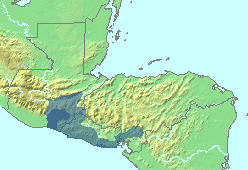Classification
The Xincan languages have no demonstrated affiliations with other language families. Lehmann (1920) tried linking Xincan with Lencan, but the proposal was never demonstrated. [2] An automated computational analysis (ASJP 4) by Müller et al. (2013) [3] also found lexical similarities between Xincan and Lencan. However, since the analysis was automatically generated, the grouping could be either due to mutual lexical borrowing or genetic inheritance.
The Xincan languages were formerly regarded as one language isolate. However, the most recent studies suggest they were indeed a language family. [4]
History
Xincan languages have many loanwords from Mayan languages especially in agricultural terms, suggesting extensive contact with Mayan peoples. [6] According to Campbell, Xinca also has a "vast number of Mixe-Zoquean loanwords", suggesting contact with now extinct Mixe-Zoque varieties of the Guatemalan Pacific coast. [7]
In the 16th century the territory of the Xinca extended from the Pacific coast to the mountains of Jalapa. In 1524 the population was conquered by the Spanish Empire. Many of the people were forced into slavery and compelled to participate in the conquest of modern-day El Salvador. It is from this that the names for the town, river, and bridge "Los Esclavos" (The Slaves) are derived in the area of Cuilapa, Santa Rosa.
After 1575, the process of Xinca cultural extinction accelerated, mainly due to their exportation to other regions. This also contributed to a decrease in the number of Xinca-language speakers. One of the oldest references concerning this language was presented by the archbishop Pedro Cortés y Larraz during a visit to the diocese of Taxisco in 1769.
Contemporary situation
Xinca was most recently spoken in seven municipalities and a village in the departments of Santa Rosa and Jutiapa. In 1991, it was reported that the language had only 25 speakers; the 2006 edition of the Encyclopedia of Language and Linguistics reported fewer than ten. [8] Nonetheless, of the 16,214 Xinca who responded to the 2002 census, [9] 1,283 reported being Xinka speakers, most probably semi-speakers or people who knew a few words and phrases of the languages. [10] However by 2010, all completely fluent speakers have died, leaving only semi-speakers who know the languages.
Distribution
Xincan languages were once more widespread, which is evident in various toponyms with Xincan origins (Campbell 1997:166). These toponyms are marked by such locative prefixes as ay- "place of" (e.g. Ayampuc, Ayarza), al- "place of" (Alzatate), san- "in" (e.g. Sansare, Sansur), or with the locative suffixes -(a)gua or -hua "town, dwelling" (e.g. Pasasagua, Jagua, Anchagua, Xagua, Eraxagua).
Kaufman (1970:66) lists the following towns as once being Xinca-speaking. [11]
Sachse (2010), citing colonial-era sources, lists the following villages in Santa Rosa Department and Jutiapa Department as having Xinca speakers during the Spanish colonial era.
This page is based on this
Wikipedia article Text is available under the
CC BY-SA 4.0 license; additional terms may apply.
Images, videos and audio are available under their respective licenses.
